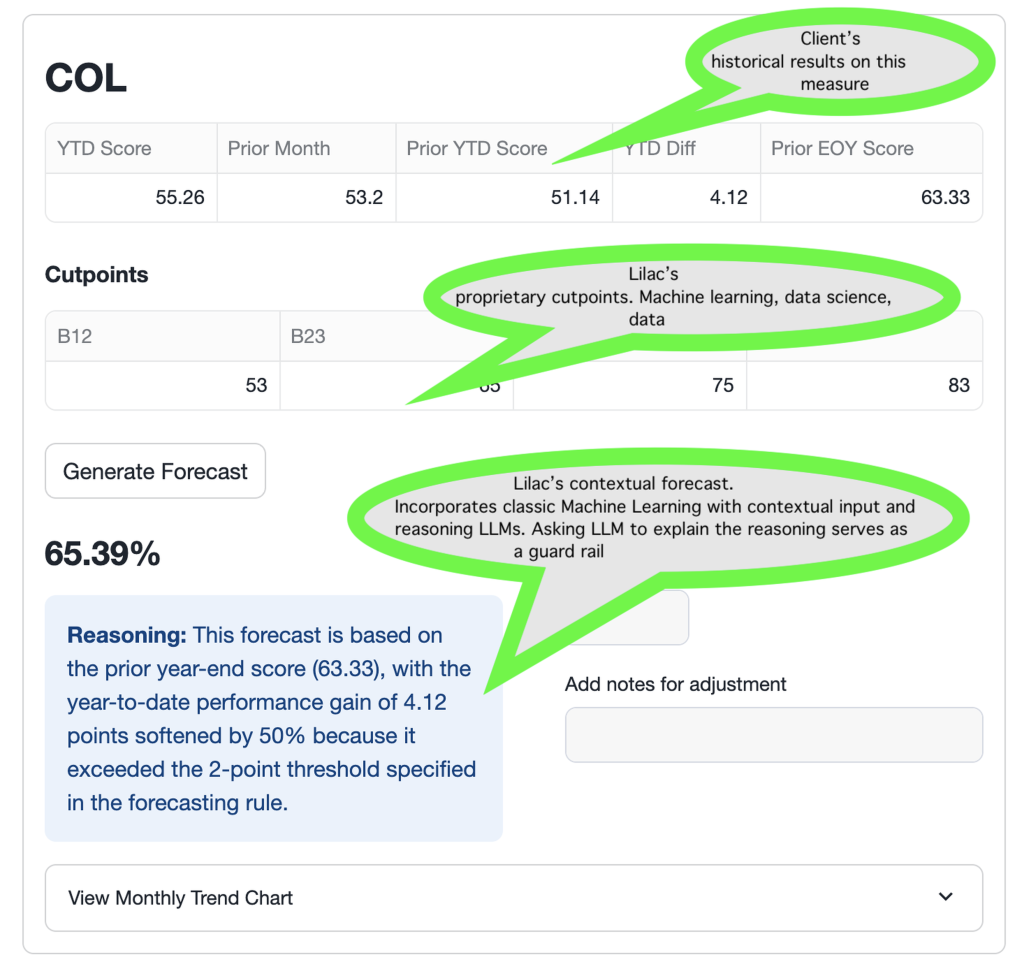Forecasting Star measures doesn’t follow a universal rule. Each measure has distinct performance drivers that require contextual understanding to predict accurately. For example, Breast Cancer Screening depends heavily on member outreach campaigns and seasonal scheduling patterns—with performance often spiking after targeted interventions. Diabetes care coordination measures follow different rhythms driven by medication adherence cycles and chronic care management program effectiveness.
A rules-based system might apply the same improvement trajectory to both measures, missing the fact that screening measures often show sudden jumps from successful campaigns while chronic care measures demonstrate gradual, sustained improvements. Similarly, medication adherence measures respond to pharmacy network changes and formulary updates in ways that preventive care measures simply don’t.
Traditional forecasting models have struggled to do this at scale. Each rules based forecast is overlaid with experts in the field applying their gut and intuition.
The latest iterations of the reasoning models combined with traditional machine learning offer an unprecedented opportunity to contextually forecast at scale. It is possible to forecast each individual measure with its own set of nuance adjustments based on data, geography and plan’s membership and history.
This is not science fiction, it is available from Lilac today.
Contextual AI vs Rules based forecasting
Traditional forecasting systems apply universal logic across all quality measures—”If measure X improved by Y% last quarter, expect Z% improvement this quarter”—without understanding the unique behavioral patterns, seasonal variations, and operational contexts that actually drive performance. But now, contextual AI opens the door to forecasting that works the way healthcare actually works: complex, interconnected, and deeply contextual.
The emergence of advanced reasoning models creates an unprecedented opportunity for health plans to leapfrog decades of limitations in quality prediction. For the first time we can move beyond rigid rules-based systems to AI that truly understands the nuanced context driving healthcare outcomes.
Latest reasoning models understand the nuances and context for each measure for each plan along with a multitude of other variables to determine the right forecast for a specific measure. Below is an example of how we do forecasting at Lilac. It’s a streamlit app that we built in Snowflake for demonstration purposes. This comes pre-built and incorporated into the AI and Cloud native Lilac Stars Management Platform.

Contextual AI Forecasting in Lilac’s Star Platform
This isn’t a research project or proof-of-concept. Contextual AI forecasting is live on our platform today. Health plans can connect their existing data sources and immediately begin benefiting from AI-powered predictions that understand their unique operational context and measure-specific performance drivers.
The maturation of HIPAA compliant cloud infrastructure and advanced reasoning models has opened the door to a new era of healthcare analytics. We’re moving beyond one-size-fits-all rules to AI that understands the complex, interconnected factors driving real-world outcomes. For healthcare, this represents a chance to leapfrog decades of analytical limitations and unlock insights that were simply impossible before.
—————————————-
Lilac Software’s Star Management Platform uses contextual AI for highly accurate forecasts in automated dashboards. If you’re interested in learning how these systems can better support your Star efforts, reach out here to start a conversation with the Lilac team.
